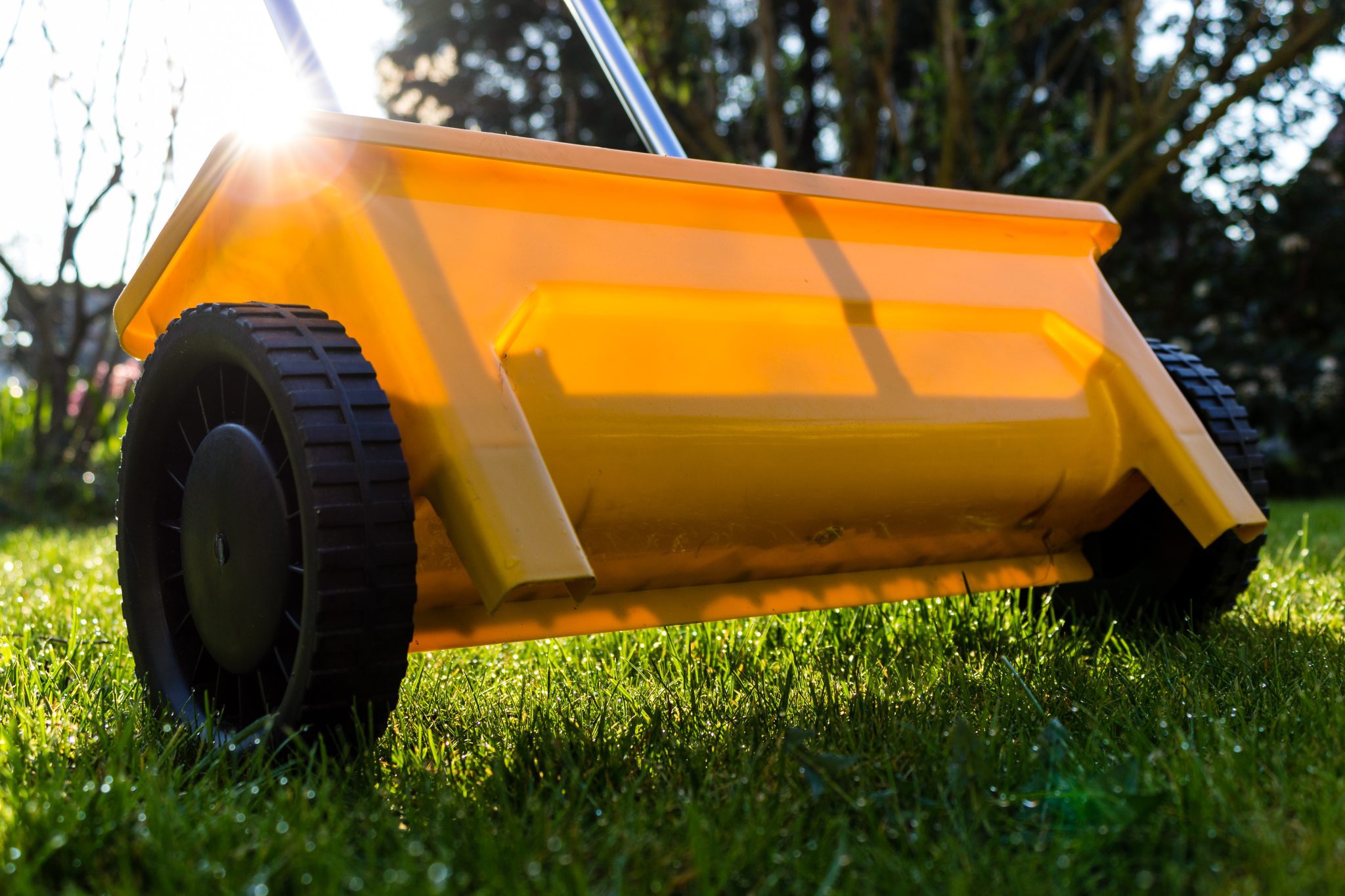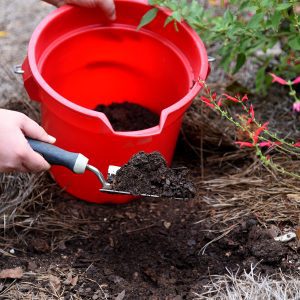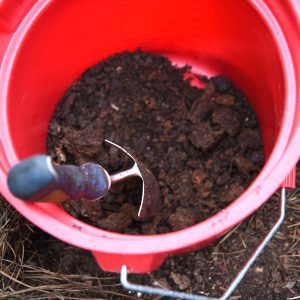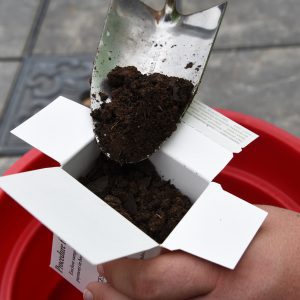Landscaping

Soil Testing
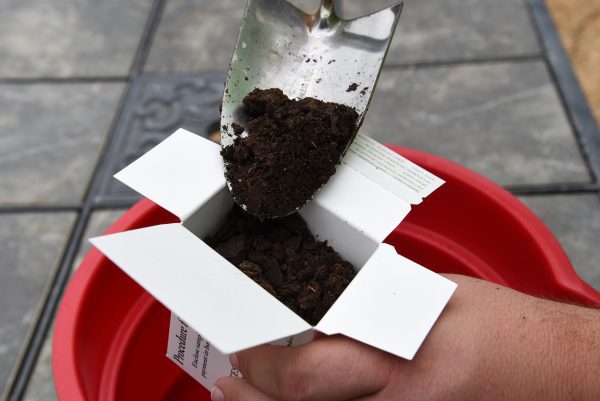
Follow instructions to be sure that you are taking a representative soil sample for analysis.
Proper soil sampling ensures accurate test results and gives the best recommendations. A typical soil test report shows soil pH, soil nutrient levels (phosphorus, potassium, calcium, magnesium), limestone recommendations, and additions needed.
You Will Need:
Soil Test Box and Form
Shovel or Trowel
Small Bucket
Marker or Pen
- Ask your county Extension office or a garden center about soil sample boxes and sample submission forms. Information is also available on the Alabama Extension website at www.aces. edu. Be sure to label the sample with your name, address, sample number (if sending multiples), and plant type growing in or intending to grow
in sampled area (lawn, flowering shrubs, vegetables, etc.). - Be sure to get a representative sample. Take several scoops of soil in the same planting area (flower bed, vegetable garden, lawn, or other) and mix them together in a bucket. Each square foot of soil can have unique pH and nutrient contents, so it is essential to dig 10 to 15 uniform scoops from random spots in the selected planting area with the same plant types.
- Raised bed gardens. These are filled with mixtures of organic, plant-based ingredients, whether for flowers or vegetables. The standard lab tests are designed for mineral soils. Clearly label all raised bed samples to ensure accurate testing and results. A pH test might be all that
is needed. - Soil sample depth. For native soil vegetable gardens, sample to the depth of tillage, typically 6′′ to 8′′ inches deep. For lawns, sample to a 3′′ to 4′′ inch depth. For shrub and tree plantings, dig samples from 3′′ to 8.”
- Label the sample. Recommendations for fertilizers are based on the plants’ needs. List the specific plants you plan to grow (shrubs, flowers, trees, etc.).
- Soil changes over time. Submit soil test samples every 2 to 3 years. For more details and to download forms, visit “Home Soil Testing: Taking a Sample” (ANR-0006-A) and “Submitting Samples for Soil Testing” on the Alabama Extension website at www.aces.edu. Send the form along with sample to the Soil, Forage, and Water Testing Laboratory at Auburn University.
- Steps in taking a soil sample for testing.
Home Lawns
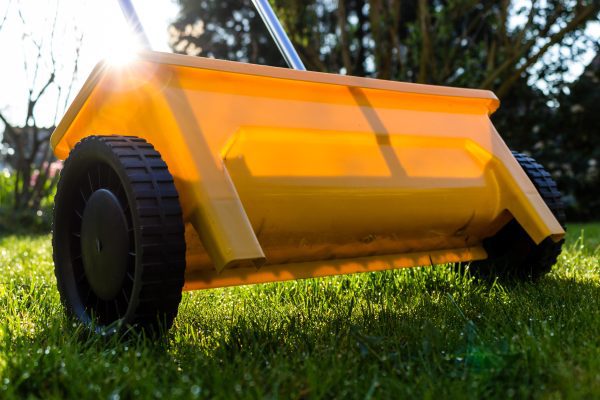
Drop spreaders help you put more material on the lawn.
Properly fertilized lawns absorb pollutants and reduce soil erosion and ambient air temperatures in summer. Overfertilizing aggravates pest problems, stimulates excessive growth, requires more maintenance, and can lead to fertilizer runoff.
You Will Need:
Soil Test Box and Form
Research
Tape Measure (optional)
Phone App (optional)
Broom
Fertilizer Spreader
- Learn which grass species you have before buying fertilizer. The nitrogen recommendation differs for each one.
- Measure the square footage. Exclude areas with shrubs, trees, and flowers. Knowing square footage ensures that the right amount of fertilizer is applied. Apps such as Google Earth can be helpful.
- Use slow-release nitrogen fertilizers. These products keep nitrogen in its place, the lawn. The label tells you the percentage of nitrogen in the fertilizer (the first number on the bag’s label).
- Do not spill! Sweep spilled fertilizer back into the lawn area.
- Do not apply to water and impervious surfaces. Keep fertilizer in planted areas.
- Do not apply if heavy rain is forecast. This prevents fertilizer runoff.
- Use drop spreaders to control granules and put more material on the lawn. This precision is less forgiving of applicator error.
- A rotary spreader is more forgiving and often preferred for DIY. Make sure to sweep or blow granules back onto the lawn.
- Do not apply fertilizer when grass is dormant. Wait until it is FULLY GREEN.
- Avoid weed-and-feed products during dormancy.
- Those with pre-emergent herbicides are safe for cool-season lawns, like fescue, when following the label.
- Those with post-emergent herbicides are safe for warm-season lawns, like bermudagrass, when following the label.
- These can injure trees and shrubs if applied in late winter or early spring.
- Apply 1 pound of nitrogen per 1,000 square feet in the months specified in table 1. Applying the minimum amount along with other recommended maintenance will grow a healthy lawn. You must specify your lawn type on the soil test submission form. Soil test recommendations will specify the amount of other nutrients missing in your soil and needed for your lawn.
- Learn more in “Home Lawn Maintenance” on the Alabama Extension website, www.aces.edu.
Table 1. Recommended Fertilization Schedule for Lawn Turfgrasses in Alabama
| Turfgrass | Standard/ Maximum for Healthy Lawn | Total pounds nitrogen/year | Jan.* | Feb.* | Mar.* | Apr.* | May* | June* | July* | Aug.* | Sept.* | Oct.* | Nov.* | Dec.* |
|---|---|---|---|---|---|---|---|---|---|---|---|---|---|---|
| Common & Hybrid Bermudagrass | Standard | 3 | 1 | 1 | 1 | |||||||||
| Common & Hybrid Bermudagrass | Maximum | 5 | 1 | 1 | 1 | 1 | 1 | |||||||
| Centipedegrass | Standard | 1 | 1/2 | 1/2 | ||||||||||
| Centipedegrass | Maximum | 2 | 1/2 | 1/2 | 1/2 | 1/2 | ||||||||
| St. Augustinegrass | Standard | 2 | 1 | 1 | ||||||||||
| St. Augustinegrass | Maximum | 4 | 1 | 1 | 1 | 1 | ||||||||
| Tall Fescue | Standard | 3 | 1 | 1 | 1 | |||||||||
| Tall Fescue | Maximum | 4 | 1 | 1 | 1 | 1 | ||||||||
| Zoysiagrass | Standard | 2 | 1 | 1 | ||||||||||
| Zoysiagrass | Maximum | 3 | 1 | 1 | 1 |
Choosing Fertilizer
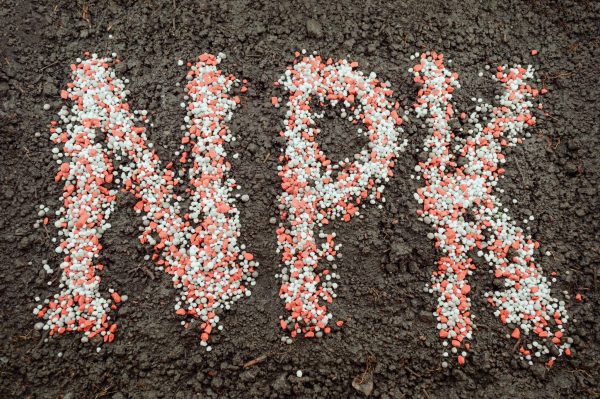
Use the lime and fertilizer calculators on the Alabama Extension website at www.aces.edu to determine the right amounts to apply.
Select a fertilizer by reading the label. For example, a 50-pound bag of 16-2-8 contains 16% nitrogen (8 pounds), 2% phosphorus (1 pound), and 8% potassium (4 pounds). Buy one that closely matches the soil test recommendations.
You Will Need:
Soil Test Box and Form
Research
Slow-Release Fertilizer
- Perform a soil test. Results provide recommendations for the right amount of fertilizer for each planting area (lawn, shrubs, vegetables, other).
- Follow soil test recommendations. Overfertilization can lead to nutrient runoff and plant health problems.
- Read the label. Know the percentage of each nutrient in the products being considered. Compare your soil test recommendations and buy products that match closely.
- Find soil test recommendations in the notes at the bottom of your soil test report. Insert these numbers into one of our calculators to learn which fertilizer to buy.
- Read the label for P and K. If your soil test indicates that no phosphorus (P) is needed, buy a zero-phosphorus (or near zero) product. The potassium (K) should be either half as much as the percentage of nitrogen (example: 16- 2-8) or equal to the amount of nitrogen (example: 15-0-15).
- Buy slow-release fertilizers. Slow- release is better, especially for nitrogen. “Slow-release” means that plant roots take up the fertilizer before nutrients are lost to runoff. Slow-release fertilizers support steady growth rather than rapid, short-term growth.
- Make smart fertilizer choices by reading the label to find the right product—smart for the soil, the plants, and water quality.
Recycling Yard Waste
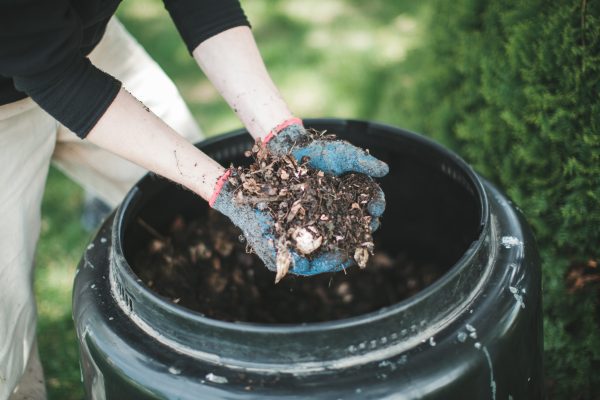
Keep compost moist. It should be crumbly, not soggy wet.
Mowing, pruning, and raking generate yard waste. Dumping this waste into storm drains or waterways harms aquatic habitats and is illegal. Composting recycles plant nutrients and keeps an on-site resource on site.
You Will Need:
Mower
Compost spot
Compost bin (optional)
Shovel
Water hose
Rake
- Leave grass clippings on your lawn. Mowing by the One-Third Rule means clippings are tiny enough to decompose quickly, returning up to 25% of the nitrogen and other nutrients that a lawn needs.
- The One-Third Rule. Mow often enough so that each mowing removes no more than one-third of the grass height.
- Compost yard clippings. Composting the leaves, branches, and lawn clippings provides a free supply of slow-release fertilizer.
- Chip woody materials. Rent, buy, or share a chipper with neighbors. Chipping large materials into small bits makes them compost faster.
- Add compost to new plantings. Compost improves soil structure, increases water holding capacity, improves drainage, promotes soil fertility, and supports soil microbes. Mix in no more than a 3′′ to 4′′ layer to new plantings. Scatter a 1⁄2″ to 1″ layer on established planting beds.
- Lazy composting. Put fall leaves, thin layers of grass clippings, and small branches behind shrubs or in a hidden corner of the yard. This process is slower but still results in beneficial compost.
- Compost recipe. Add yard waste and kitchen scraps (no meat or fat) to bins for faster compost. Mixing a small scoop of soil or finished compost brings microorganisms to the recipe. Add a little water, but do not saturate the mix. Keep the brown to green ratio at 30:1 for a foolproof process.
- Self-mulched areas. Allow natural areas under some trees. Consider that the forest mulches itself.
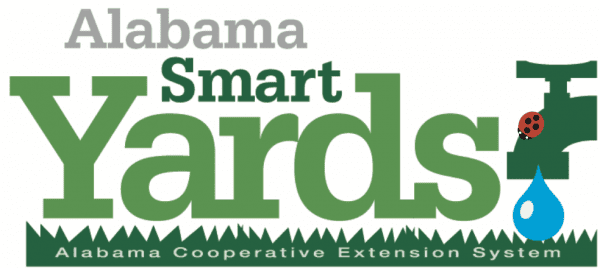
 Kerry Smith, Administrator, Outreach Programs, Horticulture, Auburn University
Kerry Smith, Administrator, Outreach Programs, Horticulture, Auburn University
Revised May 2023, Fertilize with Care – Smart Yards Recipe Series, ANR-2872-C

